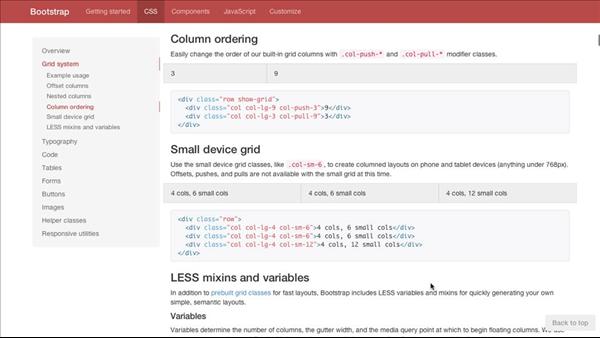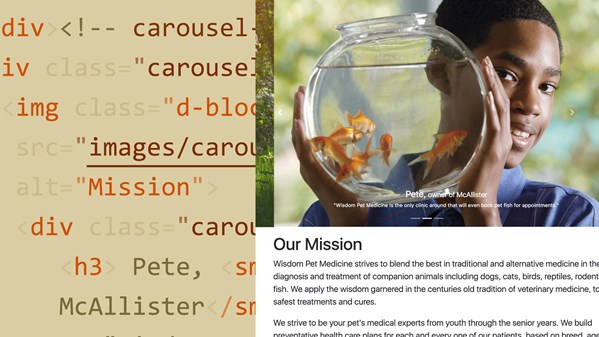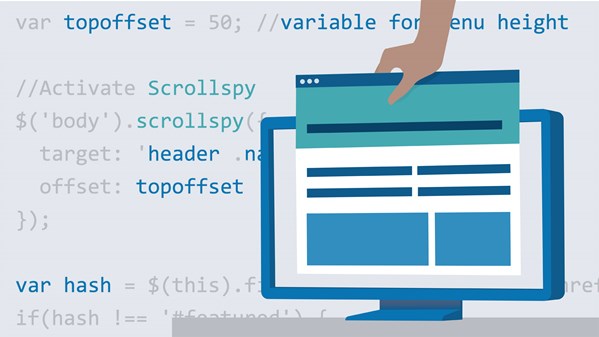
Bootstrap—a front-end framework using HTML, CSS, and JavaScript—is designed to help developers quickly and easily build responsive, mobile-ready websites that are cross-browser compatible. An open-source framework, Bootstrap features a 12-column grid and components that are ready to use. In this course, Ray Villalobos helps you get started with Bootstrap 5, providing an overview of all of the features in this popular framework. Ray covers installation options, and walks through the basic styles that normalize how your content is displayed on different platforms and browsers, before moving into detailed coverage of more advanced features, including typography and flexbox layouts. Learn how to use the layout components to create a full-featured website and make it interactive with components such as carousels, accordions, alerts, and tooltips. Plus, learn how to build beautifully designed and usable forms that validate user input.
Deze cursus is enkel beschikbaar in het Engels. Als dit voor u geen probleem vormt, dien dan gerust uw aanvraag in.
This course is in French only. If this is not a problem for you, by all means go ahead and apply.

Bootstrap is a popular framework designed for building responsive, accessible, and mobile-ready websites. An open-source platform using HTML5, CSS3, and jQuery, it features a 12-column grid, icons you can incorporate into your designs, and fully functional JavaScript components that are ready to use. This course provides everything you need to know to get started building websites with Bootstrap, and is built with our new practice environments in mind, which let you develop your code along with author Ray Villalobos. Ray will review Bootstrap's grid, CSS classes, and JavaScript components (dropdowns, modals, carousels, and more), and help you integrate them into your own sophisticated websites..
Topics include:
-
Understanding containers
- Using the 12-column grid to create a responsive webpage layout
- Creating rows and columns
- Styling content with Bootstrap CSS classes
- Adding CSS styles
- Creating and styling forms
- Creating dropdown menus and buttons
- Adding images and video
- Exploring JavaScript components, like carousels, tabs, tool tips, and scrolling

Bootstrap 3 is here, and it supports mobile design and responsive CSS better than ever. Join author Ray Villalobos for an overview of the new classes, mobile-first approach, and other enhancements in Bootstrap 3, and learn how to migrate your sites and files to the new framework. Find out about the new installation options, updates to grids and scaffolding, and changes to the handling of type, images, and JavaScript. Then learn to integrate the new list group and panel components into your workflow. The course closes with a look at migrating a sample site from Bootstrap 2.3 to 3.0, from replacing template files to tweaking your grid, navigation, and images.
Topics include:
- Installing Bootstrap 3
- Using the new grid systems
- Working with typography
- Understanding the responsive class updates
- Using panels and list groups
- Migrating from Bootstrap 2.3 to Bootstrap 3.0

Bootstrap—a front-end framework using HTML, CSS3, and jQuery—is designed to help developers quickly and easily build responsive, mobile-ready websites that are cross-browser compatible. An open-source framework, Bootstrap features a 12-column grid and components that are ready to use. In this course, Ray Villalobos helps you get started with Bootstrap by providing an overview of all of the goodies in this popular framework. Ray covers the installation options, and walks through the basic styles that normalize how your content is displayed on different platforms and browsers. He also explains how to use the flexbox grid system to build nearly any kind of layout you can dream up, use different classes to easily get around your project, work with interactive components like dropdowns and carousels, and more.
Topics include:
- Creating a basic template
- Reviewing basic styles and typography
- Using colors with Bootstrap
- Working with classes that help you deal with images
- Working with grid containers
- Offsetting columns
- Using list groups to style lists, buttons, and links
- Using breadcrumbs
- Reviewing layout components
- Using form styles
- Working with interactive components

Find out how Bootstrap 4 can transform your standard HTML websites into inspired single-page designs. This course takes a project-based approach to explaining how to manipulate website layouts with the Bootstrap framework. Throughout the course, instructor Ray Villalobos works through popular layout patterns, helping to acquaint you with concepts that are key to creating a cohesive layout with Bootstrap. Ray tackles Bootstrap layout classes and shows what it takes to customize its CSS, addressing layout challenges like multiple grids and columns. Learn how to leverage the Scrollspy plugin to track navigation, how to create an image carousel, and how to build animations. Plus, this course provides you with a ready-to-go template with which to start new projects.
Topics include:
- Building a header and footer
- Adding styles to your project
- Making your navigation responsive
- Bootstrap layout components
- Using a multicolumn format
- Creating carousels
- Adding interactivity
- Creating animations

Bootstrap 4 boasts a number of major changes and improvements to the popular front-end framework. If you've been curious about making the switch to Bootstrap 4, this course can prepare you to tackle the migration process. Join Ray Villalobos as he highlights the new features and changes you can access in this upgrade. Ray explains how to approach new components such as cards, as well as how to work with flexbox containers and display properties. After he familiarizes you with what's new in Bootstrap 4, he explains how to migrate a website from Bootstrap 3 to 4. Ray also goes over how to handle some of the more challenging aspects of the migration process, including migrating carousels and navigation tables.
Topics include:
- Reviewing the core changes in Bootstrap 4
- Using display properties
- Reviewing flexbox container options
- Designing basic cards
- Using badges
- Upgrading from Bootstrap 3
- Migrating to the new grid
- Upgrading navs
- Learning about table and form changes
- Reviewing dropdown changes
- Changing a carousel

Avec Damien Bruyndonckx, initiez-vous au langage Sass et créez des feuilles de style CSS avec plus d'aisance. Que vous soyez développeur ou intégrateur web, vous découvrirez les principes fondamentaux de Sass. Vous aborderez également les notions avancées, puis vous apprendrez à réaliser une application. À l'issue de cette formation, vous serez capable d'intégrer le langage Sass dans votre flux de travail, et vous maîtriserez la création et la maintenance de vos feuilles de style CSS.
Topics include:
Deze cursus is enkel beschikbaar in het Engels. Als dit voor u geen probleem vormt, dien dan gerust uw aanvraag in.
This course is in French only. If this is not a problem for you, by all means go ahead and apply.

Perplexed by the challenges introduced into design by all the mobile devices appearing on the market? This course shows how to evolve your current workflow to incorporate responsive design practices, without adding too much complexity or overhead. Author Justin Putney explains collaborative processes you can adopt to help designers speak to developers and developers speak to designers, and how to deal with the designer's ever-expanding role on the web. The course also covers communicating with clients and building a cohesive development team, and offers lessons on building the diagrams, wireframes, and style guides that aid a smooth workflow.
Topics include:
- What is responsive design?
- Understanding concepts like scaling and interaction mediums
- Building a team and explaining job roles
- Planning for color and typefaces
- What developers and designers should provide
- Setting client expectations
- Working with a budget
- Investigating design solutions
- Hiring team members and contractors

Modern consumers navigate the world through search. From laptops, smartphones, virtual assistants, tablets, and more, they search the wild and wondrous internet for the products and services they need. By leveraging the fundamentals of search engine optimization (SEO), you can ensure that your business pops up in these all-important search results. This course is about mastering those fundamentals. Join instructor David Booth as he covers how to make improvements that boost your website's visibility on search engines, attracting the right kind of traffic to the right pages on your site.
Explore the basics of SEO, including how to read a results page and see how rankings affect businesses large and small. Discover how to implement foundational optimization strategies and techniques, including how to conduct keyword research, build internal and external links, optimize your pages and content, measure your successes and progress, and plan for a long-term SEO strategy. Additionally, learn specific SEO tips for ecommerce, local search, and mobile audiences to expand your reach.
Topics include:
- What is SEO?
- Reading search engine result pages
- Researching keywords
- Optimizing pages for keywords
- Optimizing code and site structure
- Optimizing nontext components of a webpage
- Analyzing content quality
- Defining your audience, topics, angle, and style
- Building links to your content
- Promoting your content via social media
- Measuring SEO effectiveness
- Optimizing ecommerce sites for search
- Leveraging local SEO
- Configuring sites for mobile

Formulating a keyword strategy is one of the most important activities in marketing. Properly optimizing a website and strategically using keywords can yield visitors for years. Digital marketing expert Matt Bailey begins with the basics, covering what keywords are and what they do. Next, learn about how to find and analyze the right keywords for your business and implement them into different channels. Matt covers all the important components of choosing keywords including how to determine customer intent, identify trends, develop analytics, utilize negative keywords, and focus on what works. Finally, learn about how to measure the results, understand rankings, and establish priorities.
Topics include:
- What are keywords?
- Why are keywords important?
- Starting keyword research
- Creating a starter set
- Analyzing keyword patterns
- Reading search engine results pages (SERP)
- Mapping keywords across the customer lifecycle
- Appling keywords to optimize your website
- Choosing keywords for voice search
- Build your quality score with themes
- Apply keywords to optimize your marketing
